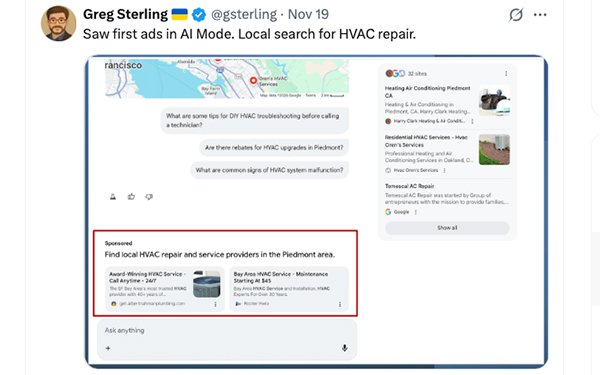
Google has begun displaying ads in
AI Mode, the company’s AI search engine, placing them at the bottom of the responses on the page. Ad results labelled with the sponsored tag resemble the organic link cards that serve up
above.
Ads were spotted by Greg Sterling, co-founder of Near Media, in Google’s Labs interface when searching
for an HVAC provider, but Brodie Clark, a search engine optimization consultant working with TripAdvisor managed to replicate it outside of Google’s experimental interface when searching for a
plumber.
“This marks a significant difference between Google's AI Mode and ChatGPT,” Clark wrote in a post on X, adding that ChatGPT does not having close to the same
infrastructure for ads as Google does.
advertisement
advertisement
With OpenAI’s ChatGPT rollout on the cusp, expected in 2026, advertisers will soon have a choice as to the AI-based engine they use to reach a
specific consumer audience. ChatGPT’s have also been spotted in recent weeks.
For advertisers, ads will become extremely important to serve up in AI Mode. BrightEdge data reveals that
direct referrals from AI engines like Google AI, ChatGPT and Perplexity to ecommerce sites hit a 752% year-over-year surge in November 2025.
It’s a reflection of consumer behavior
shifting in real time. Grocery saw a 900% spike in AI presence, furniture jumped 375%, and apparel also has climbed.
Search experts, organic and paid, note that 2025 is the first holiday
season where AI is genuinely part of the shopping experience, whether through ads or organic AI-based search traffic.
Clark has been documenting changes to AI Mode. Earlier in the week he
spotted a “checkbox” feature that displayed a button to “ask about these” results that were triggered by a query. The checkbox feature served up beside products.
There
have been several variations of this feature throughout the year where a product comparison displayed in the results.
There are challenges as AI search and ads roll out. "That first ecommerce AI door opens with a simple problem—suggesting gifts for people who seemingly have everything,” said Jim Yu,
BrightEdge chief executive officer. “But once it's open, we see what's behind it: larger purchases AI can handle, then fully autonomous ordering.”
Options are on the horizon, but
it’s not clear if consumers will eventually have the ability to click on the ad, ask for product comparisons, and then an autonomous AI-based agent will pick up the process to find comparisons
and make the purchase for consumers.